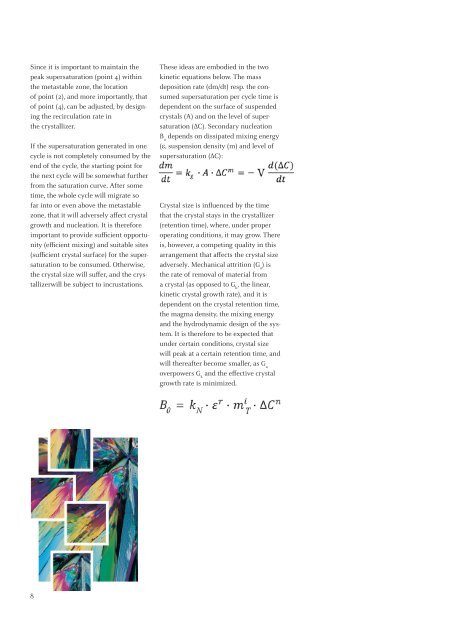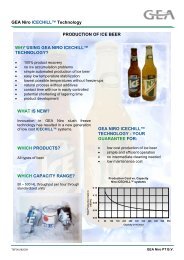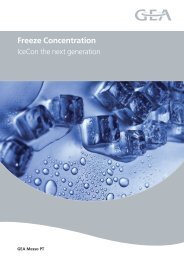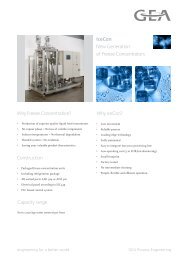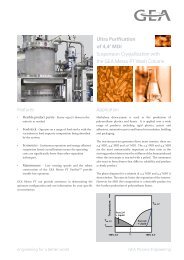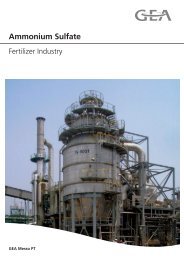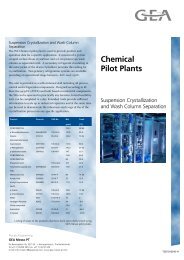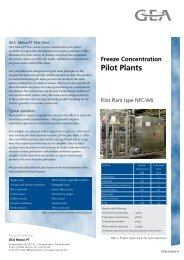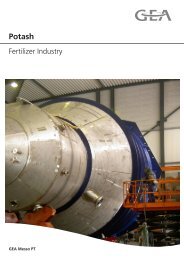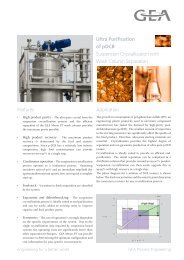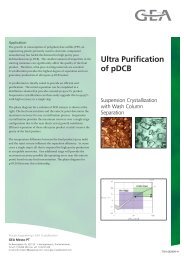Mass Crystallization - GEA Messo PT
Mass Crystallization - GEA Messo PT
Mass Crystallization - GEA Messo PT
You also want an ePaper? Increase the reach of your titles
YUMPU automatically turns print PDFs into web optimized ePapers that Google loves.
Since it is important to maintain the<br />
peak supersaturation (point 4) within<br />
the metastable zone, the location<br />
of point (2), and more importantly, that<br />
of point (4), can be adjusted, by designing<br />
the recirculation rate in<br />
the crystallizer.<br />
If the supersaturation generated in one<br />
cycle is not completely consumed by the<br />
end of the cycle, the starting point for<br />
the next cycle will be somewhat further<br />
from the saturation curve. After some<br />
time, the whole cycle will migrate so<br />
far into or even above the metastable<br />
zone, that it will adversely affect crystal<br />
growth and nucleation. It is therefore<br />
important to provide sufficient opportunity<br />
(efficient mixing) and suitable sites<br />
(sufficient crystal surface) for the supersaturation<br />
to be consumed. Otherwise,<br />
the crystal size will suffer, and the crystallizerwill<br />
be subject to incrustations.<br />
These ideas are embodied in the two<br />
kinetic equations below. The mass<br />
deposition rate (dm/dt) resp. the consumed<br />
supersaturation per cycle time is<br />
dependent on the surface of suspended<br />
crystals (A) and on the level of supersaturation<br />
(ΔC). Secondary nucleation<br />
B 0<br />
depends on dissipated mixing energy<br />
(ε, suspension density (m) and level of<br />
supersaturation (ΔC):<br />
Crystal size is influenced by the time<br />
that the crystal stays in the crystallizer<br />
(retention time), where, under proper<br />
operating conditions, it may grow. There<br />
is, however, a competing quality in this<br />
arrangement that affects the crystal size<br />
adversely. Mechanical attrition (G a<br />
) is<br />
the rate of removal of material from<br />
a crystal (as opposed to G k<br />
, the linear,<br />
kinetic crystal growth rate), and it is<br />
dependent on the crystal retention time,<br />
the magma density, the mixing energy<br />
and the hydrodynamic design of the system.<br />
It is therefore to be expected that<br />
under certain conditions, crystal size<br />
will peak at a certain retention time, and<br />
will thereafter become smaller, as G a<br />
overpowers G k<br />
and the effective crystal<br />
growth rate is minimized.<br />
8


